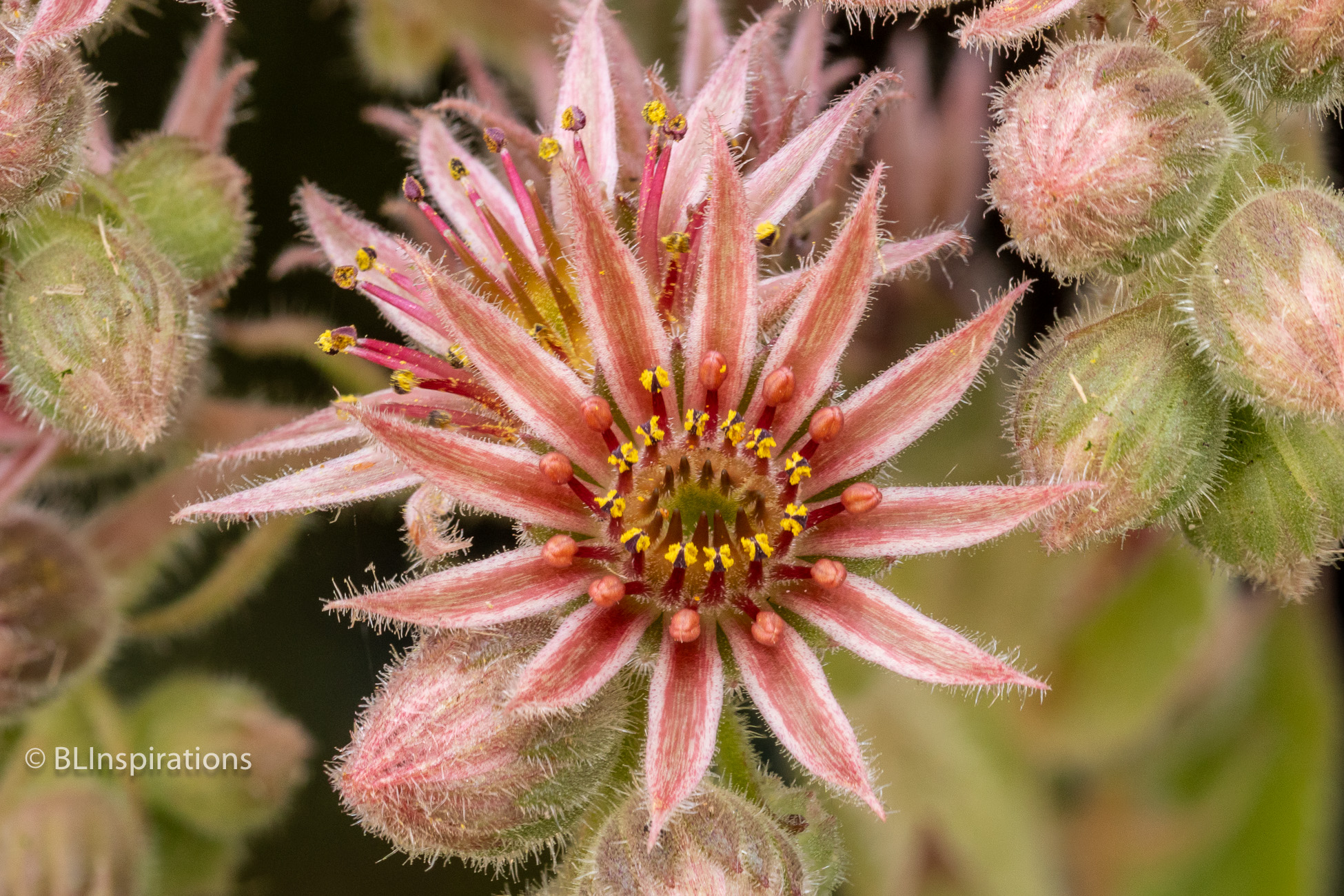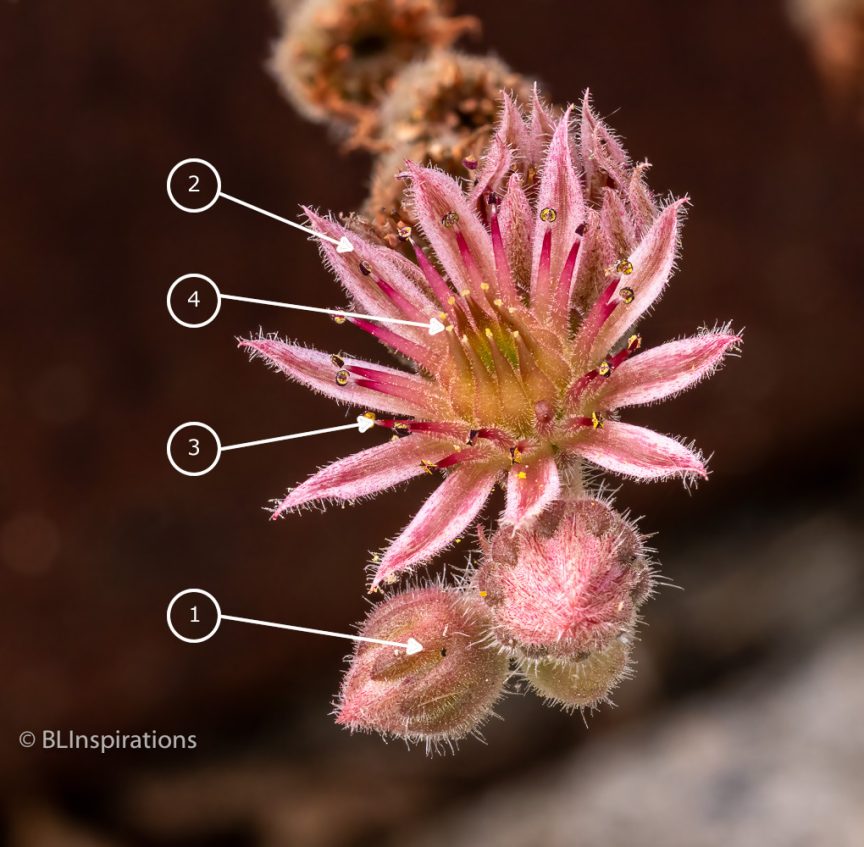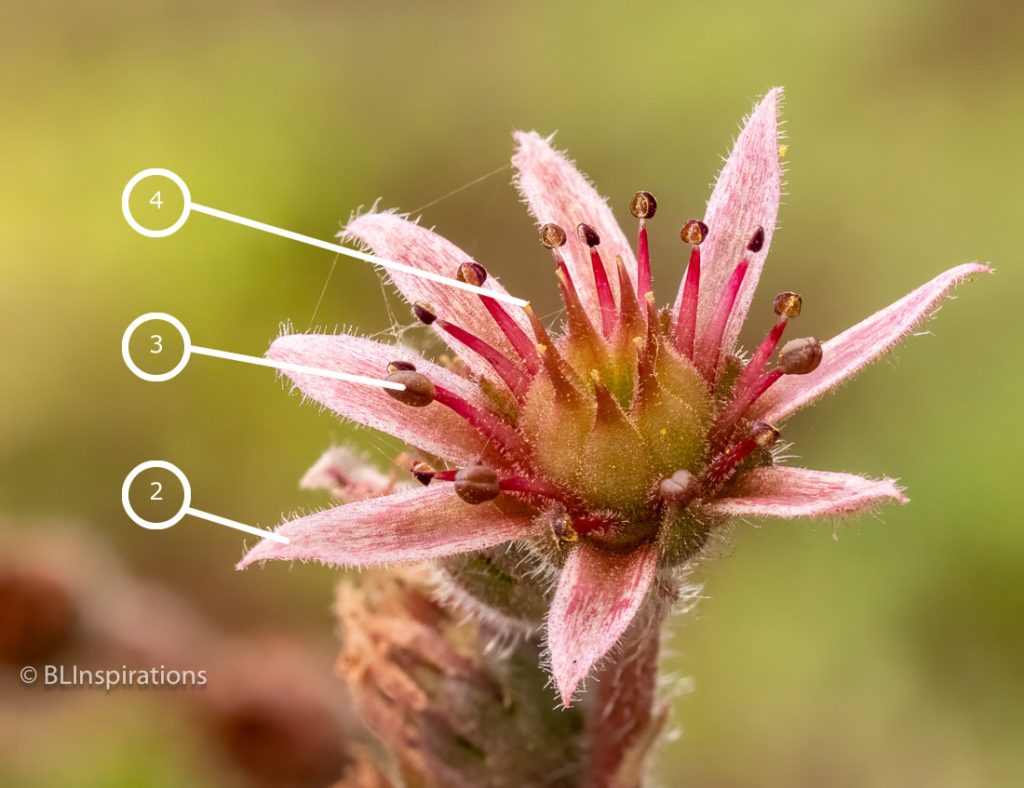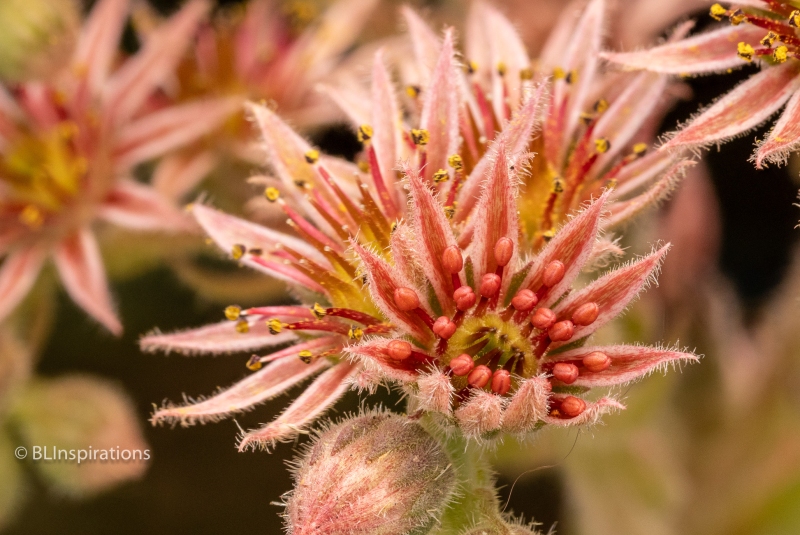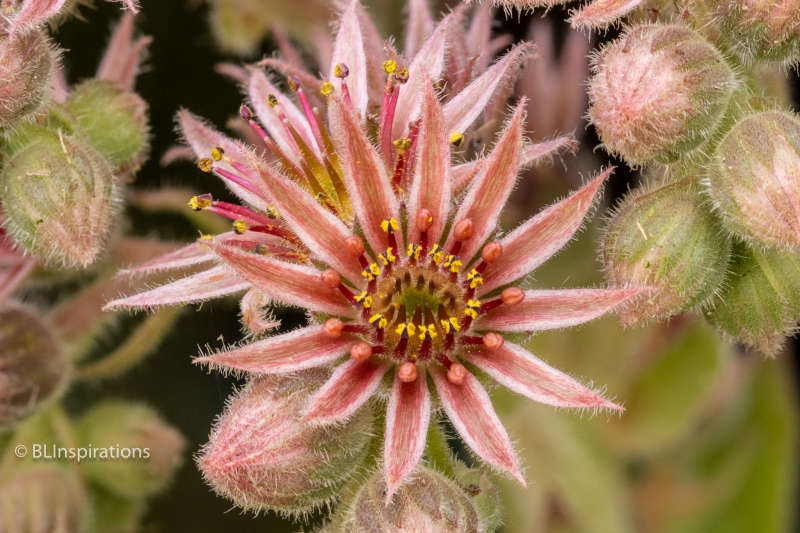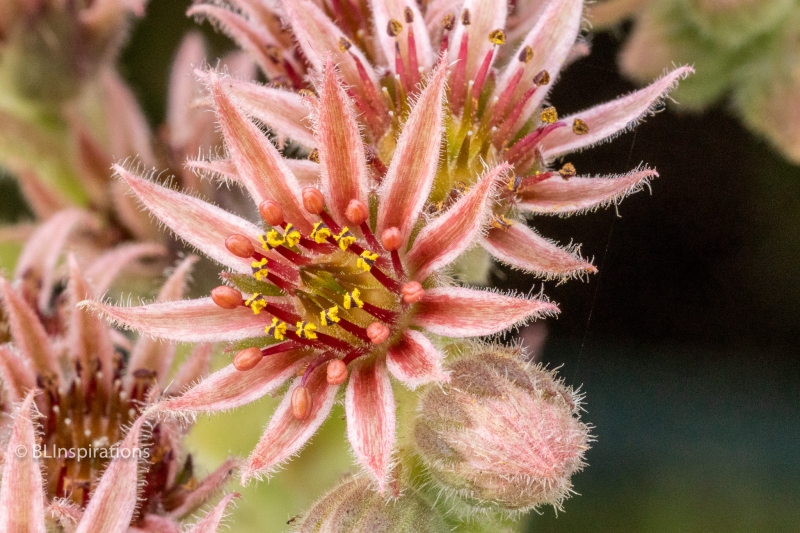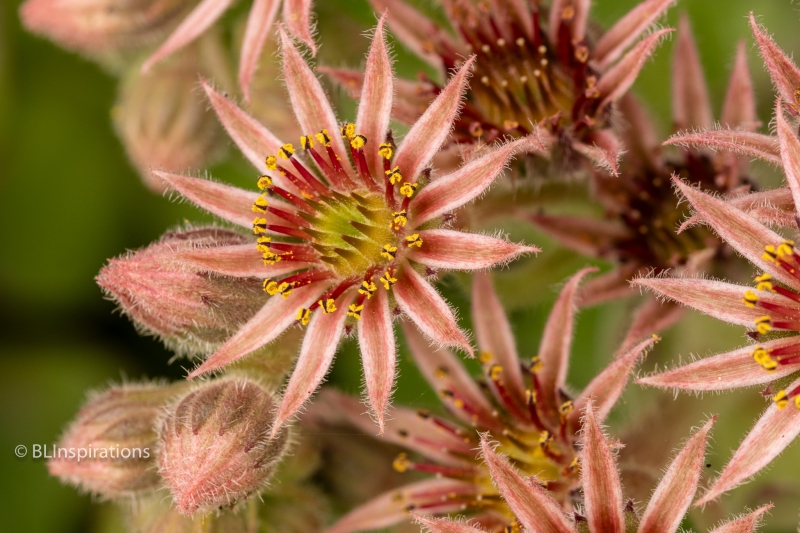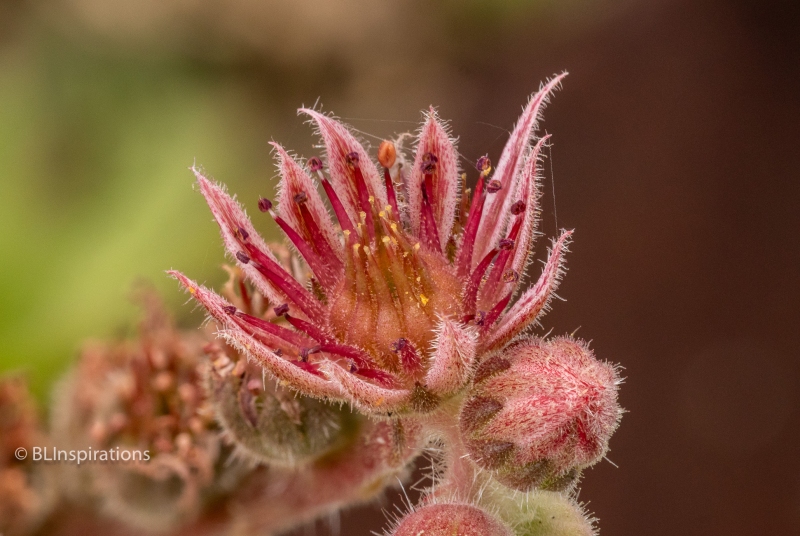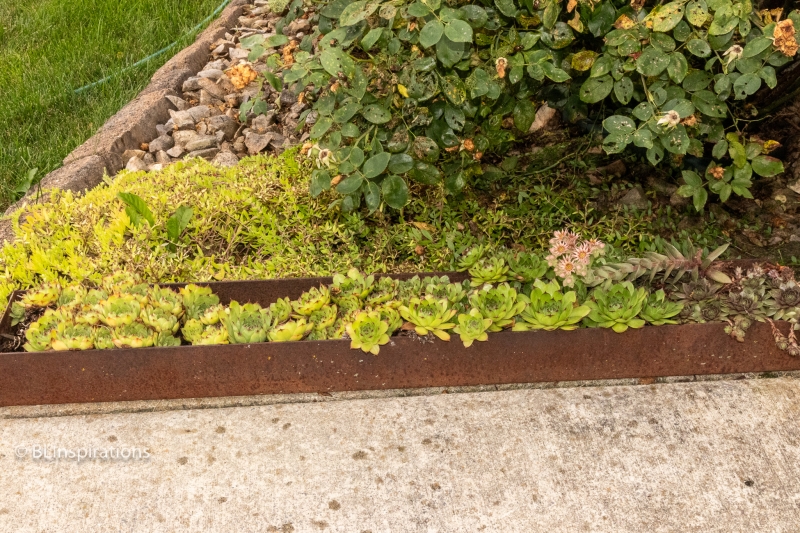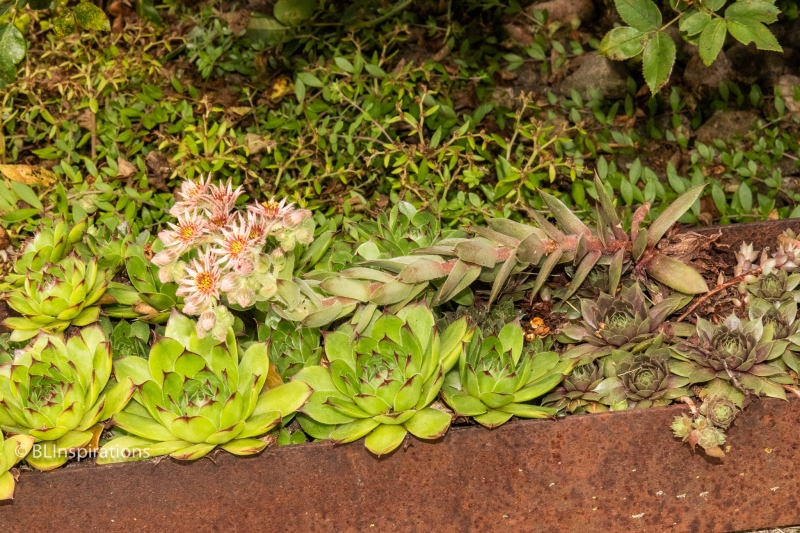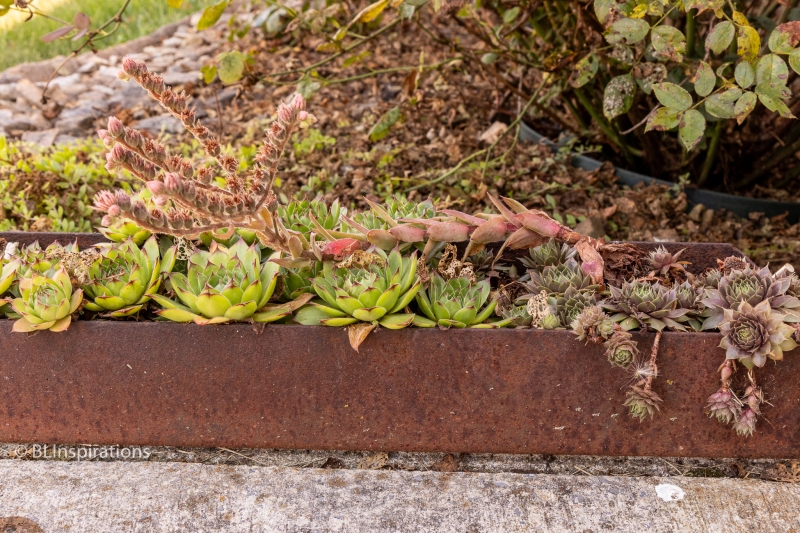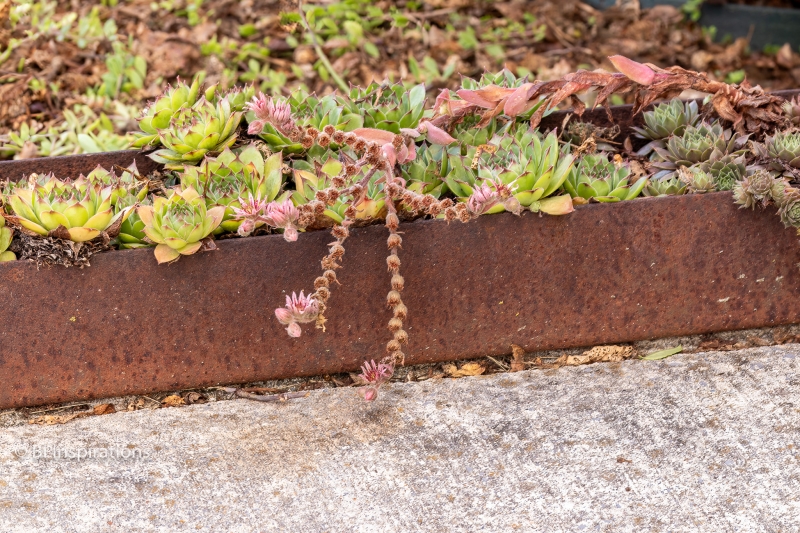Beverly brought a long metal tray of hen and chicks succulents to our home in Lacey Spring when we first got together (there is a photo of that container in the Additional Images gallery below). When we moved to Broadway, we put it along the sidewalk near the front entrance steps. Recently (this past July), Beverly noticed one of the plants was blooming, which was interesting because in the previous seven years, we do not remember seeing any of them bloom.
The plant known as hen and chicks is actually the common houseleek (Sempervivum tectorum). It is known as hen and chicks because of the way new plantlets (offsets – ‘chicks’) develop in a cluster around the parent plant. It is a succulent, native to the mountains of southern Europe. The botanical name Sempervivum is Latin for “live forever” which actually refers to the new offsets that spread the plant.
It is often found in rock gardens, as a border front, in rock crevices, along stone walls, as a small area ground cover, and as an edging for foundations. It also makes an excellent indoor or outdoor container plant. These plants are often tucked into the crevices of a rock wall, which provides a good balance of drainage, radiant heat, and protection for the plant’s roots.
This succulent is monocarpic, which means it flowers only once, and then the mother plant dies. It will live on, however, via the offsets it produces. The plant usually blooms only after producing several generations of offsets, after a number of years have passed. Densely packed flower buds form at the ends of a thick stalk that is 8-12″ long (there are photos of the stalk and the flowers in the Additional Images gallery below). In this plant, the buds formed on separate branches that grew from the end of the stalk, and some of the branches divided into more branches, as can be seen in the last image in the Additional Images gallery below. The branches grow longer as new buds form at their ends and the older flowers wither and die. The flowers are about ¾” across.
Houseleek Flower Parts
The houseleek flower consists of four main parts, from the outside to the inside of the flower. These parts are identified in the photos below – click a photo to view a larger image:
- Sepals – the outermost parts of the flower which protects the bud before it opens
- Petals – the colorful, leaf-like structures that surround the reproductive organs of the flower
- Stamens – the male reproductive organs of the flower which consist of a filament and an anther, where pollen is produced
- Pistil – the female reproductive organs of the flower which consist of a stigma, a style, and an ovary. The stigma receives the pollen and the style is the tube which connects the stigma to the ovary.
Additional Information
Sempervivum tectorum – North Carolina Extension Gardener
Do Hens and Chicks (Sempervivum) Plants Bloom? – Gardner’s Path
Wikipedia – Sempervivum
Sempervivum Blooms: A Visual Guide – Mountain Crest Gardens
Additional Images
These images were taken over a one month period as the plant continued to grow more buds and flowers. The first five images in the gallery are focus stacked macro images which show Houseleek blossoms as they develop (for more information about macro photography and focus stacking, please see the Definitions & Apps page). The later images show the flowers at the end of the stalk, the whole metal tray, and the stalk as numerous flowers have finished blooming.
Technical Data
Houseleek Flower 1
- Date: 7/13/2023
- Time: 3:53 PM
- Camera: Canon EOS 77D
- Lens: Sigma 105 mm f/2.8 EX DG OS HSM Macro
- Settings:
- Lens: 105 mm, f/11
- ISO: 800
- Shutter: 1/50 sec
- Cropped image is 4175 x 2790 px
- Image: 3 images – Focus Stacked
Houseleek Flower 2
- Date: 7/11/2023
- Time: 3:39 PM
- Camera: Canon EOS 77D
- Lens: Sigma 105 mm f/2.8 EX DG OS HSM Macro
- Settings:
- Lens: 105 mm, f/11
- ISO: 400
- Shutter: 1/25 sec
- Cropped image is 4647 x 3098 px
- Image: 4 images – Focus Stacked
Houseleek Flower 3
- Date: 7/10/2023
- Time: 4:49 PM
- Camera: Canon EOS 77D
- Lens: Sigma 105 mm f/2.8 EX DG OS HSM Macro
- Settings:
- Lens: 105 mm, f/16
- ISO: 1600
- Shutter: 1/30 sec
- Cropped image is 4360 x 2907 px
- Image: 2 images – Focus Stacked
Houseleek Flower 4
- Date: 7/8/2023
- Time: 7:13 PM
- Camera: Canon EOS 77D
- Lens: Sigma 105 mm f/2.8 EX DG OS HSM Macro
- Settings:
- Lens: 105 mm, f/8
- ISO: 200
- Shutter: 1/13 sec
- Cropped image is 5283 x 3522 px
- Image: 2 images – Focus Stacked
Houseleek Flower 5
- Date: 7/26/2023
- Time: 4:19 PM
- Camera: Canon EOS 77D
- Lens: Sigma 105 mm f/2.8 EX DG OS HSM Macro
- Settings:
- Lens: 105 mm, f/11
- ISO: 800
- Shutter: 1/30 sec
- Cropped image is 4522 x 3027 px
- Image: 5 images – Focus Stacked
Houseleek pan with flowers
- Date: 7/8/2023
- Time: 7:21 PM
- Camera: Canon EOS 77D
- Lens: Canon EF-S 17-55 mm f/2.8 IS USM
- Settings:
- Lens: 23 mm, f/16
- ISO: 1600
- Shutter: 1/60 sec
- Cropped image is 5419 x 3612 px
Houseleek stalk with flowers
- Date: 7/8/2023
- Time: 7:20 PM
- Camera: Canon EOS 77D
- Lens: Canon EF-S 17-55 mm f/2.8 IS USM
- Settings:
- Lens: 52 mm, f/16
- ISO: 1600
- Shutter: 1/60 sec
- Uncropped image is 6000 x 4000 px
Houseleek stalk with blooming and dead flowers
- Date: 7/23/2023
- Time: 3:27 PM
- Camera: Canon EOS 77D
- Lens: Canon EF-S 17-55 mm f/2.8 IS USM
- Settings:
- Lens: 28 mm, f/8
- ISO: 400
- Shutter: 1/60 sec
- Cropped image is 5237 x 3491 px
Houseleek stalk with mostly dead flowers
- Date: 8/4/2023
- Time: 4:55 PM
- Camera: Canon EOS 77D
- Lens: Sigma 105 mm f/2.8 EX DG OS HSM Macro
- Settings:
- Lens: 105 mm, f/11
- ISO: 200
- Shutter: 1/10 sec
- Uncropped image is 6000 x 4000 px
